Music of the Chicano Movement
Lesson Hub 2:
A History of Struggle:
Precursors to the Chicano Movement
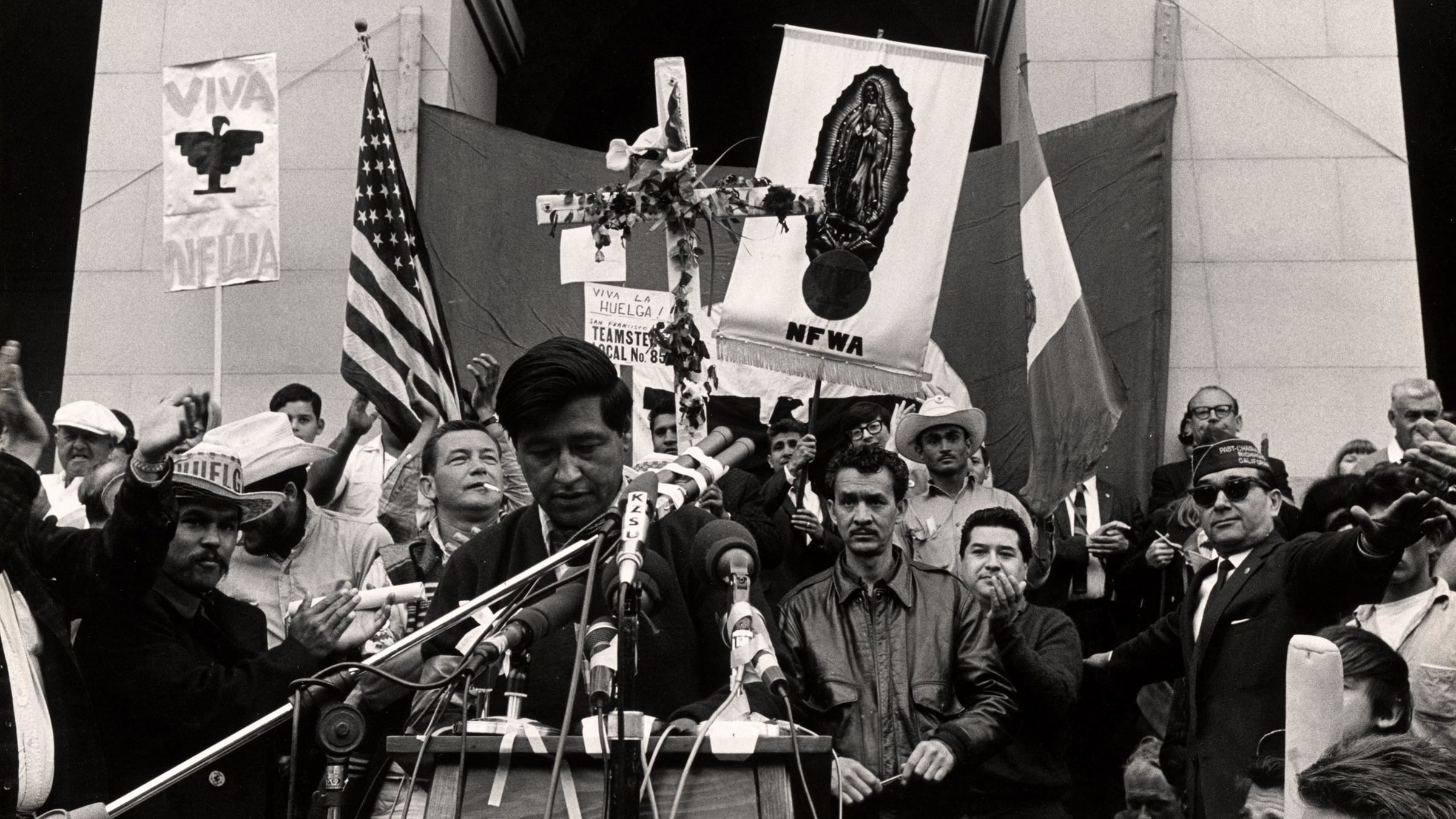

The overarching essential question for Lesson 2 is:
How did historical events contribute to injustices faced by members of Mexican American communities during the time of the Chicano movement?
Lydia Mendoza, Ciudad Juarez, 1937, by Ester Hernández. National Portrait Gallery.


A History of Struggle:
Precursors to the Chicano Movement

What Happened Before the Chicano Movement?
Path 1

30+ minutes


Agrarian Leader Zapata, by Diego Rivera. Photo by Peter A. Juley. Smithsonian American Art Museum.
However, it is important to remember that this history of oppression began hundreds of years before the Chicano movement started.
What happened before the Chicano movement?



An important social movement in United States history, the Chicano movement can be understood as a collective response to injustices related to discrimination, displacement, and exploitation, faced by members of Mexican American communities during the 1960s and 1970s.
A Brief Historical Timeline: Spanish Conquest

After the Spanish took control of Mesoamerica (1521), they imposed their language, institutions, and religion on the native people, frequently exploiting them for their labor.


Hernan Cortes, by D. A. Carnicero. National Museum of American History.
In fact, this history of oppression can be traced all the way back to the Spanish conquest of the Aztec Empire in the sixteenth century.
A Brief Historical Timeline: Mexico in the 19th Century



Aztlán Goal Map, created by Jaimiko. Wikimedia Commons (PD).
A Brief Historical Timeline: The Mexican American War

The Storming of Chapultepec, by James Walker. National Museum of American History.


Initiated by the United States in 1846, this conflict was deeply related to land disputes —disagreements about the Texas/Mexico border and a desire to acquire more land (Manifest Destiny).
The End of the War

Zachary Taylor, by James Walker. National Portrait Gallery.

The Treaty of Guadalupe Hidalgo was signed at the end of the Mexican-American War (1848).
It guaranteed US citizenship to Mexicans living in these new US territories.
It also guaranteed “rights to their land, language, religion, customs, and civil rights” (Montoya, 2016, p. 18).

The Treaty of Guadalupe Hidalgo and Land Disputes

Exchange Copy of the Treaty of Guadalupe Hidalgo. National Archives, PD (U.S. Code § 105).

Many historians agree that land grants guaranteed by the treaty were often ignored or dismissed by the courts. In some cases, Mexican American landowners were not able to afford legal fees when land disputes arose.
Despite the Treaty of Guadalupe Hidalgo, many Spanish and Mexican landowners were ultimately forced off their land by American settlers.


- Aztlán was the name of the Aztec people’s homeland in traditional migration stories.
La tierra nueva en Aztlán, paño by Manuel Moya. National Museum of American History.

Fast Forward 100+ Years ...
During the time of the Chicano movement (1960s–1970s), activists often expressed frustration about the promises of the Treaty of Guadalupe Hidalgo, which they believed had been broken.
They used the symbolic image of "Aztlán" as a reference to lost lands.
During the time of the Chicano movement, the image of Aztlán symbolized a desire to “take back” what some felt had been stolen from their ancestors after the Mexican American War and thus, belonged to them.
More About Aztlán ...



According to traditional Aztec beliefs, Aztlán was located somewhere to the north of Mexico City (perhaps even north of the US-Mexico border).

Aztlán Continued…


1704 Gemilli Map of the Aztec Migration from Aztlán to Chapultepec, by Giovanni Francesco Gemilli Careri. PD-Art (PD-US-expired).
More About Aztlán ...

Listening Activity: "Corrido de Aztlán"
During the time of the Chicano movement, many musicians also invoked the imagery of Aztlán in the songs they wrote and performed.

As you listen, underline or circle places in the lyrics that refer to Aztlán (the traditional Aztec homeland and/or the desire to reclaim lost land).
Let's listen to one example: "Corrido de Aztlán," written by Daniel Valdez and performed by Suni Paz.
Lyrics that relate to the idea of Aztlán:
- “We declare our territory”
- “Our nation is Aztlán”
- “Fight to the death for our lands”
- “The children of the sun”
- “Down with exploitation”
- “We will protect our lands”
- “We will proclaim our lands”
"Corrido de Aztlán"



The Return to Aztlán, by Alfredo Arreguin. National Portrait Gallery.
About the Performer: Suni Paz


Suni Paz (the performer) is an Argentinian-born singer-songwriter who moved to the United States in 1965.
During the Chicano movement, Suni wrote and sang songs about a variety of social issues, such as the United Farmworkers Movement, Latina women’s rights, and educational access for Latino/a children.
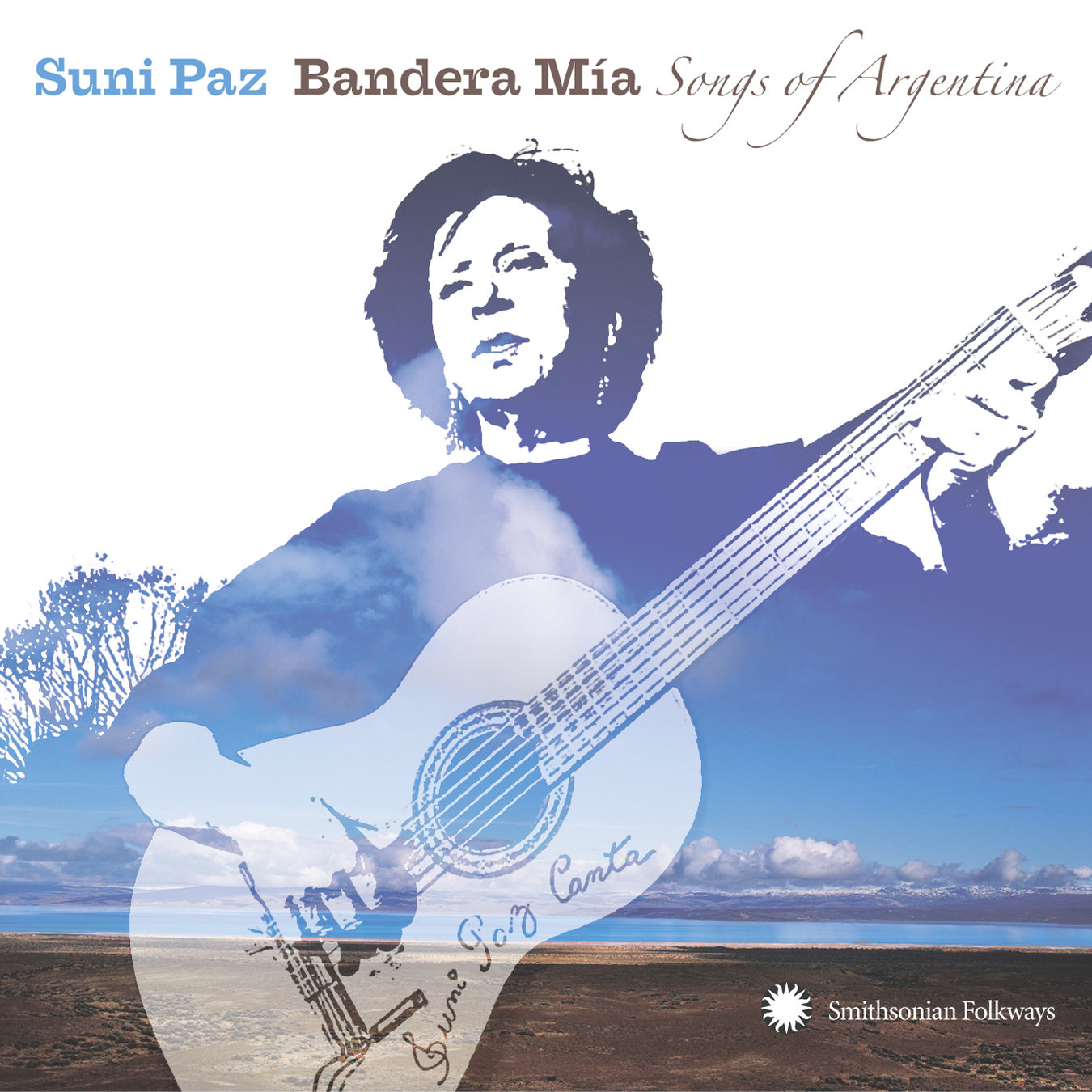
Bandera mía, cover art by Sonya Cohen Cramer. Smithsonian Folkways Recordings.
A Brief Historical Timeline: The Mexican Revolution

"¡Mátalos en caliente!" Veracruz, 25 de Junio de 1879, by Alfredo Zalce. Archives of American Art.

The Mexican Revolution (1910-1920) was another important historical event that had long-lasting implications for Mexican American communities, both in negative and positive ways.

During the Mexican Revolution . . .


Leaders, who stood up to oppressive authorities and fought for the rights of the poor, were celebrated as heroes.
Pancho Villa and Emiliano Zapata were two well-known heroes of the Mexican Revolution.


Zapata, by David Alfaro Siqueiros. Hirshorn Museum and Sculpture Garden.
Viva la revolucion, unknown artist. National Museum of American History.
During the Chicano movement of the 1960s and 70s, revolutionary figures became role models and symbols.
Fast Forward 50+ Years:
Revolutionary Figures as Role Models


Justicia, by Amado M. Peña Jr. Smithsonian American Art Museum.

They inspired and motivated people to stand up against injustice, fight on behalf of the poor, and demand change.
Chicano/a songwriters frequently referenced figures from the Mexican Revolution in their compositions (and continue to do so).
As an example, the song you listened to earlier in this Path ("Corrido de Aztlán") referenced both Pancho Villa and Emiliano Zapata.
A Brief Historical Timeline:
The Mexican Revolution and Immigration


This led to a large influx of Mexican citizens across the border and into the southwestern part of the United States.
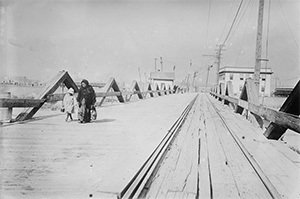
Bridge - El Paso to Juarez, Bain News Service. Library of Congress.
During and after the Mexican Revolution, many people were forced to flee their homeland (Mexico) in order to escape the violence.
Anti-Immigrant Sentiment


This wave of immigration changed the demographics of the American Southwest and triggered some anti-immigration/anti-Mexican backlash.
Some authors argue Mexicans and Mexican Americans began to “face some of the same systematic discrimination and racism directed towards blacks in the Jim Crow South” (Montoya, 2016, p. 21).
- Examples included lynching, vigilante justice, police brutality, segregation and prohibition of the Spanish language in schools, and deportation of people born in the U.S.



Mexican Immigrant, by Roberto Rios. Smithsonian American Art Museum.
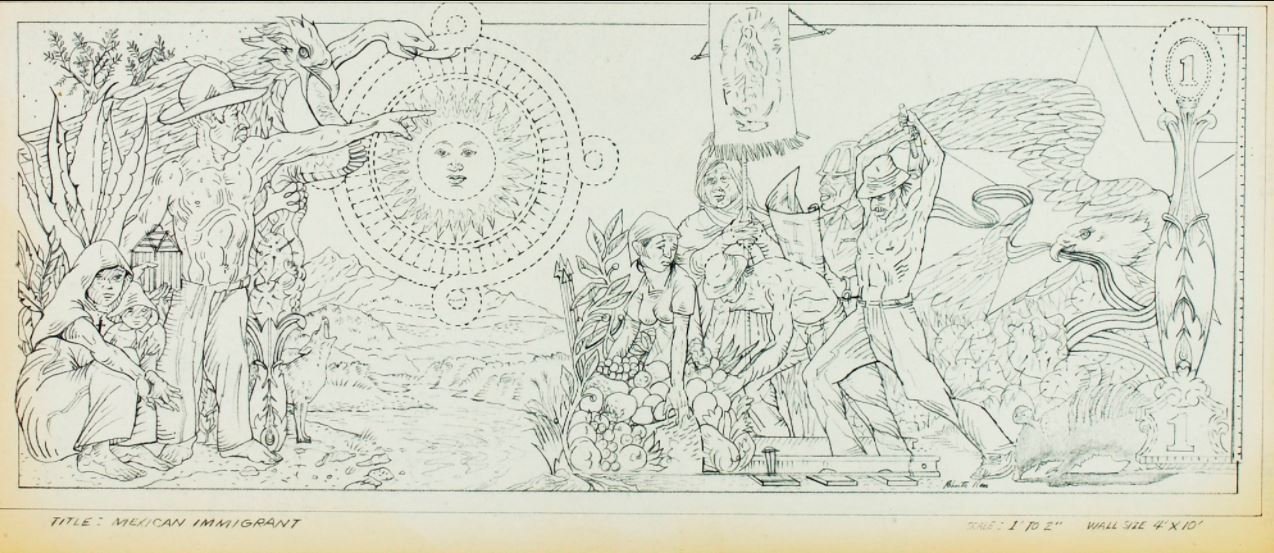
Visual Art Integration: "Mexican Immigrant"
Extension Activity: Create a Historical Timeline


Find instructions for this optional activity in the teacher's guide.







Learning Checkpoint

- What are some historical events that contributed to the injustices members of Mexican American communities faced and fought against during the Chicano movement of the 1960s–1970s.
End of Path 1! Where will you go next?






Historical Symbols and Musical Sounds
Path 2

25+ minutes


Rosita, by Robert Valadez. Robert Valadez Fine Arts.

Review: Historical Symbols and Music
The song “Corrido de Aztlán,” written by Daniel Valdez and performed by Suni Paz during and for the Chicano movement (late 1960s), includes many lyrical references to important historical and cultural events, people, and symbols (e.g., Aztlán, the Mexican Revolution, Pancho Villa, etc.).


Attentive Listening: "Corrido de Aztlán"

Listen to a short excerpt (30-45 seconds) from Suni Paz’s recording of "Corrido de Aztlán." Think about this guiding question:

El concepto de Aztlán, by Judith Hernández. UCLA Chicano Studies Research Center.
Which instrument is playing the steady beat?
The tambourine is playing the steady beat.
Listen again . . . This time, clap or tap along with the tambourine on the steady beat.
Engaged Listening: Tambourine

Tambourine. National Museum of American History.



Attentive Listening: "Corrido de Aztlán"

Listen to this short excerpt again and consider a new guiding question:
What other instruments do you hear?

El concepto de Aztlán, by Judith Hernández. UCLA Chicano Studies Research Center.

What Instruments Did You Hear?

This recording features a variety of interesting instruments, such as:
- Guitar
- Güiro
- Bongos
- Bombo Drum



From Left to Right: Güiro, Puyero de güiro (Güiro Pick), LP Bongos. National
Museum of American History.
Integrating: What is a Bombo Drum?

The bombo is a bass drum from Argentina and Chile.

Suni Paz (Guitar) and Ramiro Fernández (Bombo Drum), photo by Marcia Emerman. Paredon Records.

It has two cowhide drumheads, and its body is made from a hollowed-out tree trunk.
It is struck with a mallet (padded stick) on the drumhead, and a drumstick on the rim, producing two distinct sounds on the same drum.
Extension Activity (Enactive Listening): Make and Play a Drum!

- Using an empty container (e.g., oatmeal, coffee) students can make their own drums.
- Cover the ends of the container with plastic lids, felt, foam, rubber, etc.
- Experiment with making different sounds.
- Listen to the recording again and play along with the sound of the bombo.


Colorful Drum, 151383163 | © Lkeskinen0 |Dreamstime.com.

Attentive and Engaged Listening: "Adelita"
Next, we will listen to an excerpt from a different (but related) song:
What instrumental sounds do you hear?

Can you clap along on the steady beat?
Can you tap along with a repeated rhythm?

This live recording features:
- A female voice
- 12-string guitar
-
Audience participation (clapping)
This version of “Adelita,” a well-known Mexican folk song, was recorded by the famous Mexican American singer Lydia Mendoza at 67 years old (1982).


Lydia Mendoza, Ciudad Juarez, 1937, by Ester Hernández. National Portrait Gallery.
"Adelita" Instrumentation

Attentive Listening: "Adelita"
What are two words would you use to describe Lydia Mendoza's voice on this recording?

Listen to the same short excerpt at least two more times, and think about new guiding questions.

What do you think this song is about (what/who is an "Adelita")?
Adding Context: What is an Adelita?

Although this well-known song was originally written about one particular female soldier (soldadera) during the Mexican Revolution, over time, the name Adelita has been used to describe women "warriors": women who are willing to fight for their rights.


Adelita, by Al Rendón. Smithsonian American Art Museum.
Adding Context: La Adelita During the Chicano Movement

“La Adelita” has become an inspirational symbol of female empowerment and action . . . an Adelita is a heroine of sorts.


During the Chicano movement, activists and musicians invoked the historically powerful image of La Adelita, as they fought for social change and women’s rights.
About the Performer: Lydia Mendoza

Lydia Mendoza herself can be viewed as an “Adelita”: She was a trailblazer who made her voice heard.
Lydia Mendoza - First Queen of Tejano Music. Cover art by Beth Weil. Arhoolie Records.


- She was a solo female artist who sang exclusively in Spanish.
- She possessed a clear, powerful voice and accompanied herself on a 12-string guitar.
- Throughout her over 70-year career, she recorded over 100 songs, and gave over 1000 live performances.
Extension Activity: Research Adelitas / Women Warriors!

- In what other cultures, times, and places can we see examples of women warriors?


- Find an example of an “Adelita” in another context.
- Share what you discover with the class!
- Find an example of a song about a strong woman from any culture, time, or place. Compare the song with the song "Adelita."

Learning Checkpoint
- What types of historical symbols did musicians reference during the time of the Chicano movement?
- What instrumental timbres did Suni Paz and Lydia Mendoza use in their recordings of "Corrido de Aztlan" and "La Adelita"?

End of Path 2: Where will you go next?






Music and the Mexican American Generation
Path 3

45+ minutes


Zoot Suit, by Ignacio Gomez. Smithsonian American Art Museum.
Mexican Americanism: The Early 20th Century

Workers and immigrants (many of whom fled violence during and after the Mexican Revolution) tended to view the United States as a temporary place of residence, and many longed for the day when they would be able to return “home” (Mexico).


Old Mexico, by Morris Henry Hobbs. National Museum of American History.
In the early part of the twentieth century, many people in Mexican American communities maintained a deep connection to the "Mexican" part of their identities.
Shifting Identities: The 1940s

The 1940s marked a distinct identity shift within Mexican American communities.


During this time, people began to embrace the United States as their permanent home, although many still felt “stuck” in between two cultures: Neither fully Mexican nor fully American.
What is Assimilation?

During this time (the 1940s and 50s), a rising number of Mexican Americans wanted to assimilate more fully into American society.
Cultural assimilation is the process by which a person or group’s culture comes to resemble that of another group (usually the dominant group).


The Mortar of Assimilation, by C. J. Taylor. National Museum of American History.
What did attempts to assimilate look like during this time?


- Speaking English only
- Wanting to be classified as white only (e.g., on the Census form)
- Demonstrating loyal citizenship and patriotism
- Faith in the educational system
- Faith in the “American Dream” (anyone can achieve middle-class status with hard work)
- Changing/"Americanizing" one’s name
- Embracing American popular culture (including musical styles like rock and roll)

"The Mexican American Generation"

During the 1940s and 1950s, the prevailing attitude among Mexican Americans was one of hope.

Although there were pockets of resistance to the idea of assimilation, many Mexican Americans believed that “if they just tried hard enough, American society would embrace them” (Montoya, 2016, p. 50).
People who were born and lived during this time are sometimes referred to as the “Mexican American Generation.”

Americans All: Let's Fight for Victory, by Leon Helguera. National Archives.
Artist Spotlight: Ritchie Valens

Ritchie Valens (born Richard Steven Valenzuela) was a musician who lived during the 1940s and 1950s. He experienced some of the pressure to assimilate that was common in the Mexican American community during this time.
Ritchie Valens, widely regarded as the first Mexican American rock and roll star, died in a tragic plane crash at the young age of 17.
Pacoima Mural Memorial, by Levi Ponce. Photo by Circe Denyer. PD, via PublicDomainPictures.net.

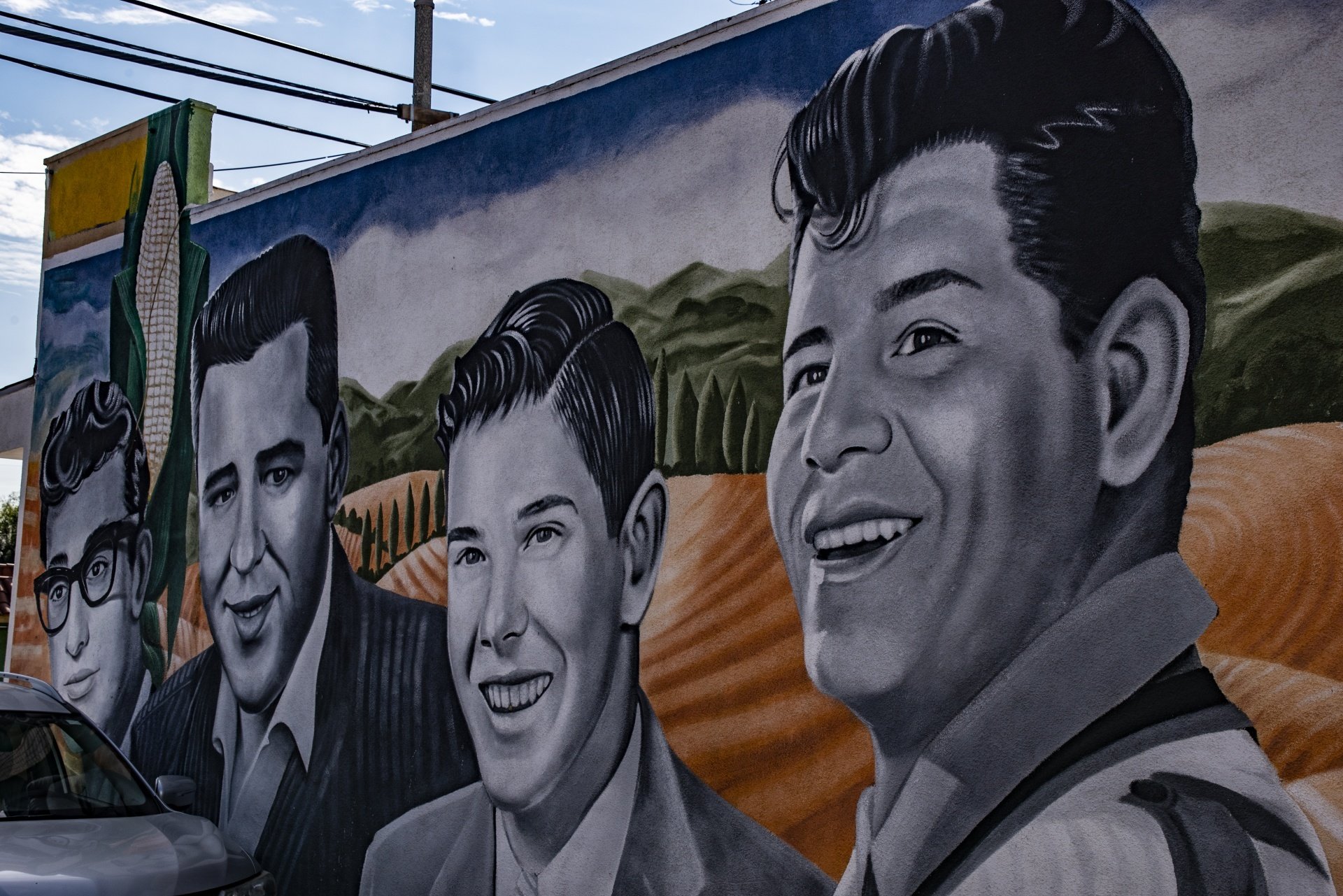


- Born in California in 1941 to Mexican immigrant parents
- Spoke very little Spanish at home
- Learned to play the guitar at age 11
- Played a wide variety of styles…from Mexican folk to rock and r&b
- Like many Mexican Americans, he experienced racial discrimination during childhood and adolescence.
- At his agent’s urging, he Americanized his name to be more marketable.
- His death (along with Buddy Holly and the Big Bopper) was memorialized by Don McLean in the song “American Pie.”
More about Ritchie Valens



Ritchie Valens: Optional Extension Activities

The Origins of "La Bamba"

Did you know? Ritchie Valens’s most famous hit song, “La bamba,” was originally a Mexican folk song (more specifically, a son jarocho - a popular regional style from Veracruz).

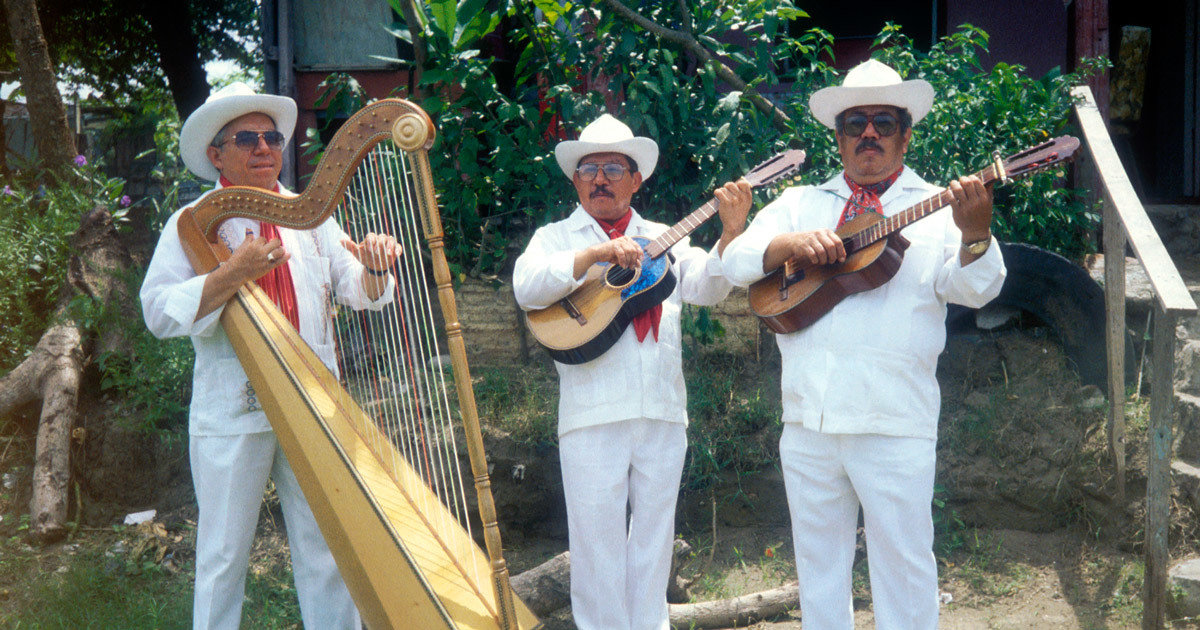
Arpa jarocha, jarana jarocha, and requinto jarocho, photo by Daniel Sheehy. Musicians pictured are José Gutiérrez and Los Hermanos Ochoa. Smithsonian Folkways Recordings.
- It has an associated dance and is often played/performed at weddings and other special events.
"La bamba" (like other sones jarochos) is traditionally played using the instruments shown here: arpa jarocha (harp) and jarana and requinto jarocho (guitar-like instruments).

Listening Activity: "La bamba"
In this listening activity, you will identify similarities and differences between a more traditional interpretation of “La bamba” and the version made famous by Ritchie Valens.
- Pay attention to the ways in which the performers apply music elements and expressive qualities.
- Consider using the provided “Attentive Listening” worksheet to keep track of your observations.


"La bamba" (Traditional Version)
First, let's listen to a traditional version of “La bamba,” as played by José Gutiérrez and Los Hermanos Ochoa (musicians from Veracruz, Mexico).



"La bamba" (Ritchie Valens's Version)
Now it is time to listen to Ritchie Valens’s version of “La bamba.”
Again, you can keep track of your thoughts and observations on your listening template.



"La bamba": Compare and Contrast
If time allows, spend some time comparing these two versions of “La bamba.”
Were there similarities and/or differences in:
- Tempo?
- Melody?
- Rhythm?
- Instrumentation?
- Style?
- Mood?




"La bamba" Play Along: Clap the Repeated Rhythm
Next, you will have an opportunity to engage with Ritchie Valens's version of "La bamba" in several different ways.
To begin, clap along with the bell pattern:



"La bamba" Play Along: Strum Chords
"La bamba" only has three chords (C, F, G), and the progression repeats for the duration of the song . . . which makes it a great play-along song for students who are learning to play a chordal instrument like guitar, ukulele, or piano.

After reviewing the chords listed above, listen to Ritchie Valens's version of "La bamba" again. If students are ready, they can strum along.

"La bamba" Play Along: Sing
Play Ritchie Valens's version of "La bamba" again.
This time, try to sing along.


"La bamba" Play Along: Learn a Riff
- This suggestion will work best for students who play (or are learning to play) a chordal instrument such as guitar, ukulele, or piano.

Ritchie Valens’s version of this song has a short, recognizable riff, a guitar pattern that repeats throughout the song.
Students can find an online tutorial (there are many) and learn to play it!

Perform "La bamba"!
Customize your own arrangement of "La bamba" based on the interests and skills of students in the class and perform it!
Suggestions: Students can sing, play the bell pattern, keep a steady beat on another rhythm instrument, play a simple rock beat on the drum set, play the repeated melodic riff on a guitar, electric bass, or ukulele, play chords on the piano, guitar, or ukulele, or trade improvised solos.

Considering Ritchie Valens's Rise to Fame ...

Ritchie Valens’s quick rise to fame in the 1950s is an inspiring success story, but unfortunately, this was not the norm during the 1940s and 50s.


Lonestar Restaurant Association Sign, ca. 1940s, photo by Adam Jones, PhD. Wikimedia Commons (CC-BY-SA-3.0).
Despite attempts to fully assimilate into American mainstream society by demonstrating a strong work ethic, good citizenship, loyalty, and patriotism, many members of Mexican American communities continued to face obstacles related to discrimination.

Learning Checkpoint
- Why did many Mexican Americans want to assimilate more fully into American culture during the 1940s and 1950s?
- Were most assimilation attempts during this time successful? Why or why not?
- What are some similarities and differences between a traditional version of “La bamba” and Ritchie Valens’s interpretation?

End of Path 3 and Lesson Hub 2: Where will you go next?








Lesson Hub 2 Media Credits

Audio courtesy of:
Smithsonian Folkways Recordings
Rhino Records
Images courtesy of:
Archives of American Art
The Arhoolie Foundation
Hirshhorn Museum and Sculpture Garden
National Archives
National Museum of American History
National Portrait Gallery
National Postal Museum
Library of Congress
Smithsonian American Art Museum
Smithsonian Folkways Recordings
Robert Valadez Fine Arts
UCLA Chicano Studies Research Center
TM/© 2021 the Cesar Chavez Foundation. www.chavezfoundation.org
Lesson plan materials courtesy of:
TeachRock.org

© 2021 Smithsonian Institution. Personal, educational, and non-commercial uses allowed; commercial rights reserved. See Smithsonian terms of use for more information
This Lesson was funded in part by the Smithsonian Youth Access Grants Program with support from the Society for Ethnomusicology and the National Association for Music Education.
For full bibliography and media credits, see Lesson 2 landing page.

